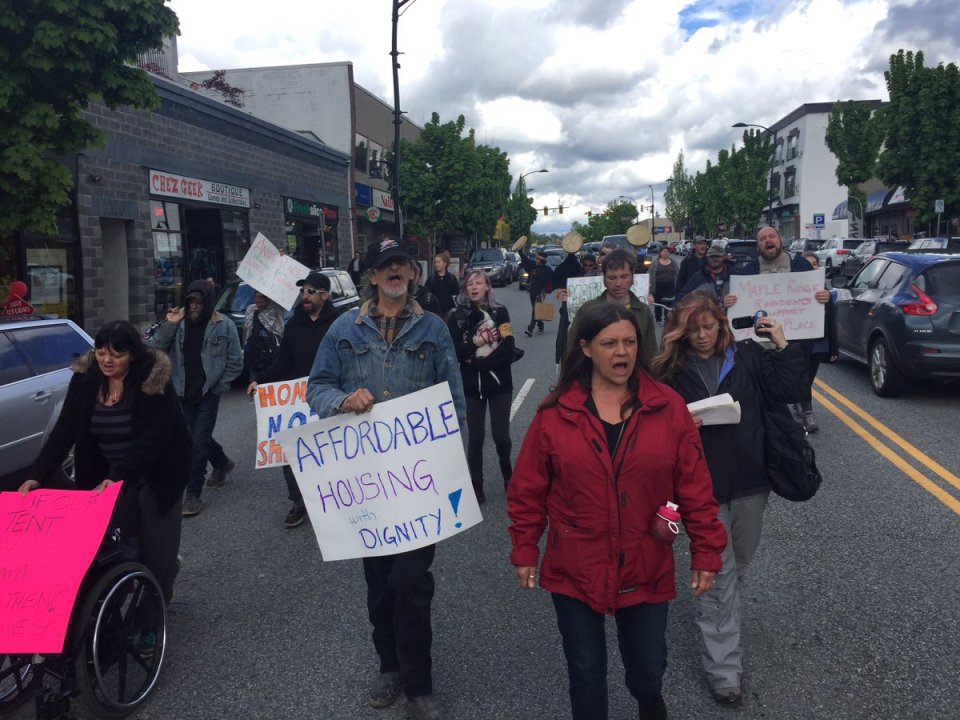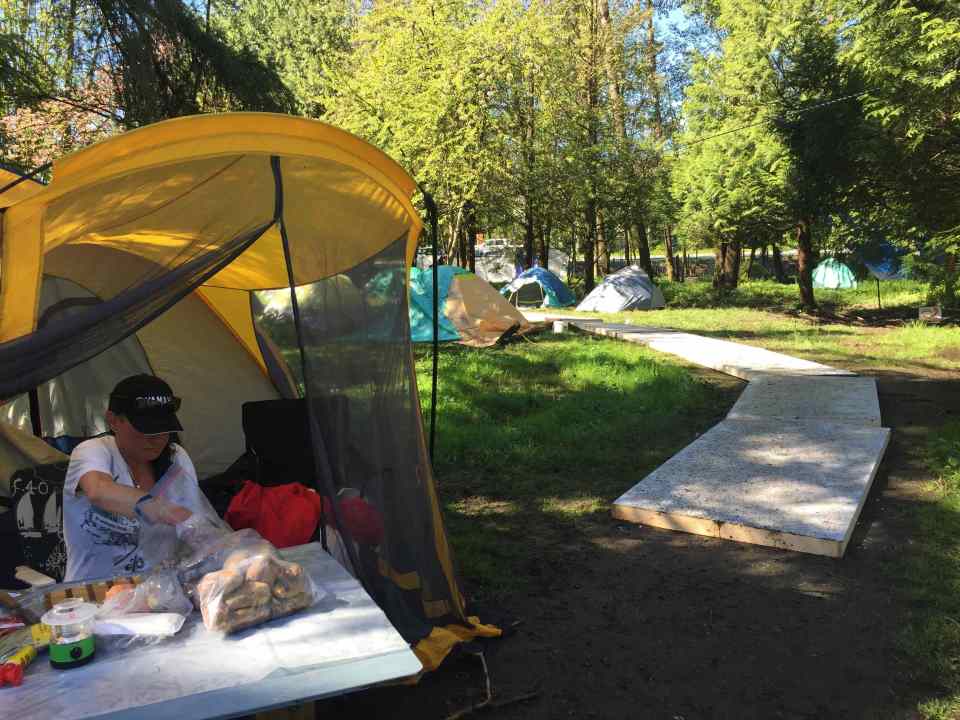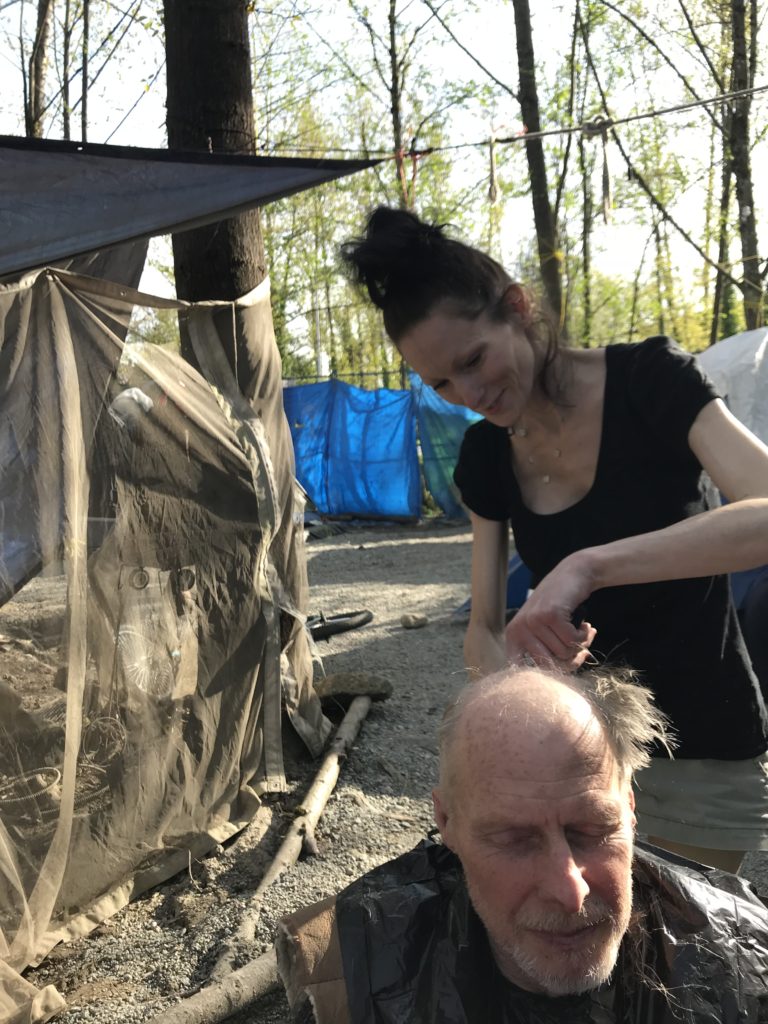
May 2nd marks the one-year anniversary of the beginning of Anita Place Tent City in Maple Ridge. Alongside celebrations being organized by campers (a walking-tour on Saturday April 28th and a townhall on Wednesday May 2nd), The Volcano is publishing a set of articles to develop a history of this camp. Anita Place has transformed life for the low-income community in Maple Ridge and has also become a foundation stone for a new movement against homelessness that goes beyond protest to resistance against the miserable conditions and vulnerability to violence, illness, and death created by government cuts to social housing and policing.
This first batch of articles includes this overview article, “Making Anita Place,” and four interviews with Anita Place campers: Mama Bear and Joey about refusing the isolation and institutionalization of supportive housing; Joe Bauman about the camp’s history of directly resisting police force; Dwayne Martin about surviving the opioid overdose genocide; and Libby about mass evictions as cause of mass homelessness. Next week, we hope to continue building this historical record with more interviews and transcripts of speeches from the anniversary events. Stay tuned!

I got to know the homeless and low-income community scene in Maple Ridge in 2015 after we read in the news that a tent city was coming under attack by anti-homeless bigots. Alliance Against Displacement and The Volcano went out to visit, and on our first day there we were impressed by the leadership at this spontaneous camp. It was led by 3 Indigenous women – Tracy Scott, Mama Bear, and Pitbull – who seemed to have the respect of everyone in the camp. I watched them organize clean-up teams, arrange water and food for people who were sick, and deal with police and city officials. We immediately tried to help by organizing a community BBQ to celebrate the campers and create bridges to the camp’s working class neighbours – who were incredibly hostile to the homeless. The hostility was so great that the BBQ was cancelled in the face of threats and a plea from the Mayor who said the City and police could not protect homeless people from violence. The experience started my long relationship with what Tracy Scott calls the “street population” in Maple Ridge.
After the Province and City of Maple Ridge closed down the camp on Cliff Avenue, I stayed in touch with Tracy, Mama Bear, and others in the community. We organized anniversary events celebrating the camp and the resilience of the low-income community. And Tracy organized delegates from the community to visit other communities in struggle – in Vancouver, Surrey, and Victoria – putting homeless people from periphery of Metro Vancouver at the centre of a broader fightback against police and bylaw efforts to criminalize and cover up homelessness as it grew and grew. But Tracy stayed focused on her major goal: she wanted to start another camp.
In the fall of 2017 Tracy and I tried, and mostly failed, to bring the community together to meet and plan a new camp. The experience of trying to bring people together to meet and talk about starting a new camp was evidence of the government machinery constantly in motion, working to block low-income people from talking or being together. We booked a meeting in the library and when I showed up two police officers were stationed outside the doors questioning a homeless man. They stayed stationed outside the doors for the beginning of our meeting when people would arrive. On a sunny day we gathered people from the shelters and met in the mostly unused parking lot behind the Taco Bell. We managed to get about a dozen people together but within 10 minutes, security guards in two trucks pulled up, got out and stood by our circle, telling us we had to leave. When we refused, they called the RCMP and two cruisers showed up – officers got out and called people in our meeting by name, breaking up the meeting.

What finally made the tent city possible was the February announcement from BC Housing that they would close the Rain City shelter. The shelter held 40 people on single beds set out side-by-side in an old mattress store on Lougheed Highway. BC Housing opened it as a way to “decamp” the Cliff Avenue tent city and it was supposed to be a temporary solution that would be a step towards permanent housing. But one plan after another (buying the hotel down the road, building a permanent shelter) was cancelled by a BC Liberal government that was more than happy to stoke and cite Ridgeilante protest as sufficient reason to cancel public spending on resources for the poor. The homeless were back exactly at the same point where they were on Cliff Avenue – there was nowhere to go but a camp.
On May 2nd 2017, one month before the closure of Rain City and one week before the BC Provincial election, Alliance Against Displacement and a small group of homeless people from the shelter held a news conference and marched to the empty lot that would become Anita Place tent city. In weekly meetings since the February announcement that the shelter would close, AAD activists worked with Tracy Scott, shelter residents, and homeless people scattered out in the bush to draft founding documents for the camp. We wrote a founding declaration in order to claim protection from the Charter of Rights and recent BC Supreme Court decisions, 5 agreements that every camper would have to agree to in order to pitch a tent, and made up guidelines about how decisions would be made in the camp and how camp governance would operate – that weekly all-camp meetings would make all major decisions and an elected camp council would make decisions in-between meetings. Tana spoke at the news conference and we marched down 223rd street. We arrived to find Tracy and Rick removing a panel from the construction fence surrounding the empty lot, and Dave frantically setting up tents inside. Tracy read out the founding declaration to the few news cameras gathered there.

Before Anita Place tent city started, most people in the community were doubtful that it was possible. Their experience was that wherever they set up a tent the police and bylaw would show up and force them to leave. They had not experienced the power of homeless and low-income people gathering together in great enough numbers with political purpose. These doubts showed in the first days of the camp. The first night, there were only a handful of people camped out in Anita Place. I stayed at the camp in my van for the first week because I was worried that the police would come and pressure people out. I wanted to keep my media call-list and my list of quick-response supporters on hand. By the end of the first week, when bylaw and RCMP tried to illegally sack the camp and intimidate us out, our numbers had doubled. And after we survived that first attack, demonstrating that the camp had the power to stand firm against police attack, then people really started to come fill Anita Place.
As an anti-displacement organizer, I see my role in peoples’ movements as shielding autonomous, oppressed community spaces and initiatives from state forces that would contain, repress, displace, or manage them. Without the support of “outside” activists, Anita Place Tent City would not have had as solid a political footing, and would likely have been smashed by bylaw and police intervention at the end of its first week. Anita Place Tent City is a space where, as an anti-capitalist and anti-colonial activist, I feel a dialectical political force that refuses simple divisions of inside/outside oppressed people and activists. Anita Place is a politically unifying force that makes homeless people activists, and binds anti-capitalist/anti-colonial activists to the immediate needs and consciousness of oppressed people.
The person who best expressed the dialectic between community and activism was Ed Grimmer, who was a founding member of Anita Place. Ed was constantly cleaning and tidying and was always present in the community spaces of camp. He kept a tent to store his things, but Ed slept sitting in a chair in the common area. I was there when a reported asked Ed why he was at Anita Place; whether it was better than camping out on his own. Ed looked at the reporter and scoffed. “I’m an activist,” he said.
One year after the founding of Anita Place, the camp has gone from feeling impossible to feeling inevitable, and it has set important political precedents that I hope homeless and low-income people in other communities pick up and use in their own defence. For me, the most important lesson is that when oppressed people organize, they first transform themselves by emerging as political actors. I am proud to organize united with these organic political leaders to build a new anti-capitalist/anti-colonial politics, and a new world.
